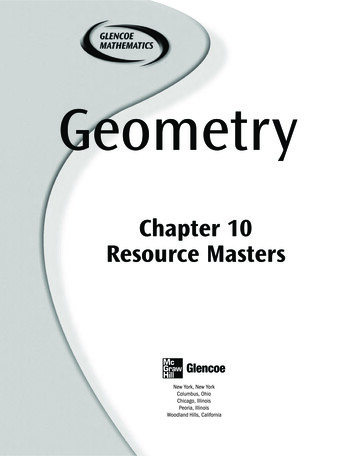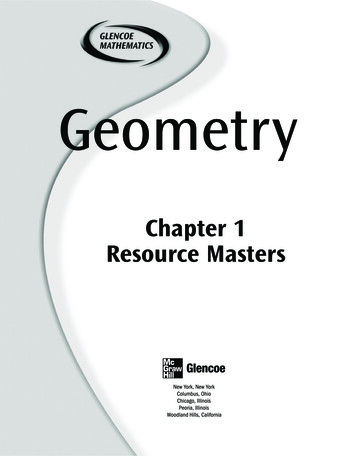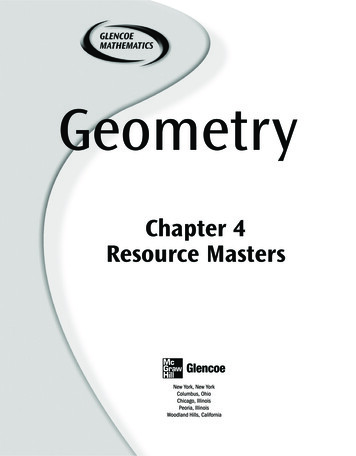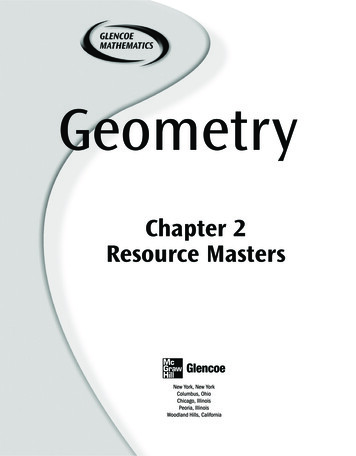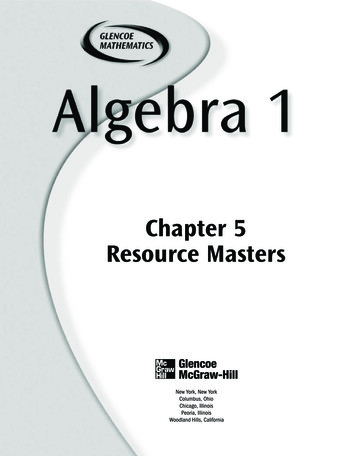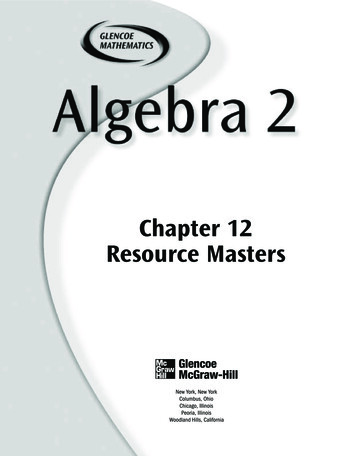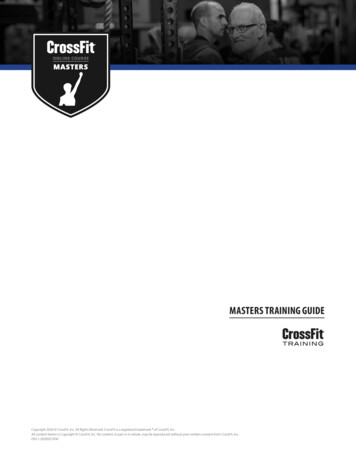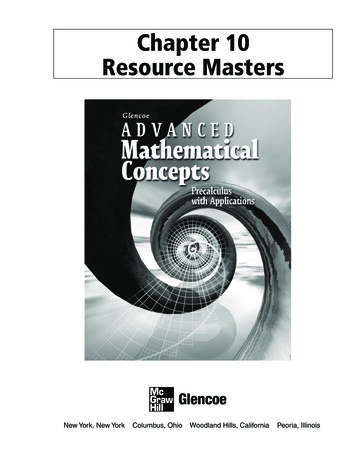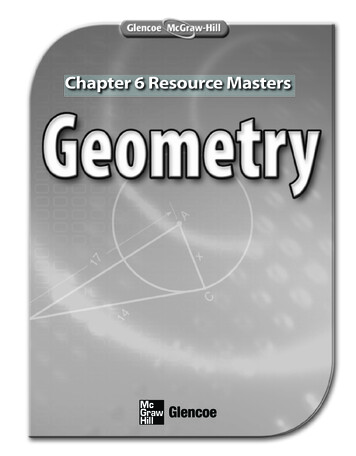
Transcription
Chapter 6 Resource Masters
Consumable Workbooks Many of the worksheets contained in the Chapter Resource Masters are available asconsumable workbooks in both English and Spanish.Study Guide and Intervention WorkbookHomework Practice 0-07-890848-4978-0-07-890849-1Spanish VersionHomework Practice Workbook0-07-890853-1978-0-07-890853-8Answers for Workbooks The answers for Chapter 6 of these workbooks can be foundin the back of this Chapter Resource Masters booklet.StudentWorks PlusTM This CD-ROM includes the entire Student Edition test along withthe English workbooks listed above.TeacherWorks PlusTM All of the materials found in this booklet are included for viewing,printing, and editing in this CD-ROM.Spanish Assessment Masters (ISBN10: 0-07-890856-6, ISBN13: 978-0-07-890856-9)These masters contain a Spanish version of Chapter 6 Test Form 2A and Form 2C.Copyright by the McGraw-Hill Companies, Inc. All rights reserved. Permission isgranted to reproduce the material contained herein on the condition that such materialbe reproduced only for classroom use; be provided to students, teachers, and familieswithout charge; and be used solely in conjunction with Glencoe Geometry program.Any other reproduction, for sale or other use, is expressly prohibited.Send all inquiries to:Glencoe/McGraw-Hill8787 Orion PlaceColumbus, OH 43240 - 4027ISBN13: 978-0-07-890515-5ISBN10: 0-07-890515-XPrinted in the United States of America.1 2 3 4 5 6 7 8 9 10 024 14 13 12 11 10 09 08
ContentsTeacher’s Guide to Using the Chapter 6Resource Masters .ivLesson 6-5Rhombi and SquaresStudy Guide and Intervention . 31Skills Practice . 33Practice. 34Word Problem Practice . 35Enrichment . 36Chapter ResourcesStudent-Built Glossary . 1Anticipation Guide (English) . 3Anticipation Guide (Spanish) . 4Lesson 6-1Lesson 6-6Angles of PolygonsStudy Guide and Intervention . 5Skills Practice . 7Practice. 8Word Problem Practice . 9Enrichment . 10Trapezoids and KitesStudy Guide and Intervention . 37Skills Practice . 39Practice. 40Word Problem Practice . 41Enrichment . 42Lesson 6-2AssessmentParallelogramsStudy Guide and Intervention . 11Skills Practice . 13Practice. 14Word Problem Practice . 15Enrichment . 16Student Recording Sheet . 43Rubric for Extended Response . 44Chapter 6 Quizzes 1 and 2 . 45Chapter 6 Quizzes 3 and 4 . 46Chapter 6 Mid-Chapter Test . 47Chapter 6 Vocabulary Test . 48Chapter 6 Test, Form 1 . 49Chapter 6 Test, Form 2A. 51Chapter 6 Test, Form 2B. 53Chapter 6 Test, Form 2C . 55Chapter 6 Test, Form 2D . 57Chapter 6 Test, Form 3 . 59Chapter 6 Extended-Response Test . 61Standardized Test Practice . 62Unit 2 Test . 65Copyright Glencoe/McGraw-Hill, a division of The McGraw-Hill Companies, Inc.Lesson 6-3Tests for ParallelogramsStudy Guide and Intervention . 17Skills Practice . 19Practice. 20Word Problem Practice . 21Enrichment . 22Lesson 6-4Answers . A24–A34RectanglesStudy Guide and Intervention . 23Skills Practice . 25Practice. 26Word Problem Practice . 27Enrichment . 28TI-Nspire Activity . 29Geometer’s Sketchpad Activity . 30iii
Teacher’s Guide to Using theChapter 6 Resource MastersThe Chapter 6 Resource Masters includes the core materials needed for Chapter 6. Thesematerials include worksheets, extensions, and assessment options. The answers for thesepages appear at the back of this booklet.All of the materials found in this booklet are included for viewing and printing on theTeacherWorks PlusTM CD-ROM.Chapter ResourcesStudent-Built Glossary (pages 1–2) Thesemasters are a student study tool thatpresents up to twenty of the key vocabularyterms from the chapter. Students are torecording definitions and/or examples foreach term. You may suggest that studenthighlight or star the terms with which theyare not familiar. Give to students beforebeginning Lesson 6-1. Encourage them toadd these pages to their mathematics studynotebooks. Remind them to complete theappropriate words as they study each lesson.Lesson ResourcesStudy Guide and Intervention Thesemasters provide vocabulary, key concepts,additional worked-out examples andCheck Your Progress exercises to use as areteaching activity. It can also be used inconjunction with the Student Edition as aninstructional tool for students who havebeen absent.Word Problem Practice This masterincludes additional practice in solving wordproblems that apply the concepts of thelesson. Use as an additional practice or ashomework for second-day teaching of thelesson.Enrichment These activities may extendthe concepts of the lesson, offer a historicalor multicultural look at the concepts,or widen students’ perspectives on the mathematics they are learning. They are writtenfor use with all levels of students.Graphing Calculator or SpreadsheetActivities These activities present ways inwhich technology can be used with the concepts in some lessons of this chapter. Use asan alternative approach to some concepts oras an integral part of your lesson presentation.Skills Practice This master focuses moreon the computational nature of the lesson.Use as an additional practice option or ashomework for second-day teaching of thelesson.ivCopyright Glencoe/McGraw-Hill, a division of The McGraw-Hill Companies, Inc.Anticipation Guide (pages 3–4) This master presented in both English and Spanish isa survey used before beginning the chapterto pinpoint what students may or may notknow about the concepts in the chapter.Students will revisit this survey after theycomplete the chapter to see if their perceptions have changed.Practice This master closely follows thetypes of problems found in the Exercises section of the Student Edition and includesword problems. Use as an additional practice option or as homework for second-dayteaching of the lesson.
Assessment OptionsLeveled Chapter TestsThe assessment masters in the Chapter 6Resource Masters offer a wide range ofassessment tools for formative (monitoring)assessment and summative (final) assessment. Form 1 contains multiple-choice questionsand is intended for use with below gradelevel students. Forms 2A and 2B contain multiple-choicequestions aimed at on grade levelstudents. These tests are similar informat to offer comparable testingsituations. Forms 2C and 2D contain free-responsequestions aimed at on grade levelstudents. These tests are similar informat to offer comparable testingsituations. Form 3 is a free-response test for usewith above grade level students.Student Recording Sheet This mastercorresponds with the standardized testpractice at the end of the chapter.Extended-Response Rubric This masterprovides information for teachers andstudents on how to assess performance onopen-ended questions.Quizzes Four free-response quizzes offerassessment at appropriate intervals in thechapter.All of the above mentioned tests include afree-response Bonus question.Copyright Glencoe/McGraw-Hill, a division of The McGraw-Hill Companies, Inc.Mid-Chapter Test This 1-page test provides an option to assess the first half of thechapter. It parallels the timing of the MidChapter Quiz in the Student Edition andincludes both multiple-choice and freeresponse questions.Extended-Response Test Performanceassessment tasks are suitable for allstudents. Samples answers and a scoringrubric are included for evaluation.Standardized Test Practice These threepages are cumulative in nature. It includesthree parts: multiple-choice questionswith bubble-in answer format, griddablequestions with answer grids, andshort-answer free-response questions.Vocabulary Test This test is suitable forall students. It includes a list of vocabularywords and 10 questions to assess students’knowledge of those words. This can also beused in conjunction with one of the leveledchapter tests.Answers The answers for the Anticipation Guideand Lesson Resources are provided asreduced pages. Full-size answer keys are provided for theassessment masters.v
NAMEDATE6PERIODThis is an alphabetical list of the key vocabulary terms you will learn in Chapter 6.As you study the chapter, complete each term’s definition or description.Remember to add the page number where you found the term. Add these pages toyour Geometry Study Notebook to review vocabulary at the end of the chapter.Vocabulary TermFoundon right Glencoe/McGraw-Hill, a division of The McGraw-Hill Companies, Inc.isosceles trapezoidlegsmidsegment of atrapezoid(continued on the next page)Chapter 61Glencoe GeometryChapter ResourcesStudent-Built Glossary
NAMEDATE6Student-Built GlossaryVocabulary TermFoundon eparallelogramrectanglerhombusCopyright Glencoe/McGraw-Hill, a division of The McGraw-Hill Companies, Inc.squaretrapezoidChapter 62Glencoe Geometry
NAME6DATEPERIODAnticipation GuideStep 1Before you begin Chapter 6 Read each statement. Decide whether you Agree (A) or Disagree (D) with the statement. Write A or D in the first column OR if you are not sure whether you agree or disagree,write NS (Not Sure).STEP 1A, D, or NSSTEP 2A or DStatement1. A triangle has no diagonals.2. A diagonal of a polygon is a segment joining themidpoints of two sides of the polygon.3. The sum of the measures of the angles in a polygon canbe determined by subtracting 2 from the number of sidesand multiplying the result by 180.4. For a quadrilateral to be a parallelogram it must havetwo pairs of parallel sides.Copyright Glencoe/McGraw-Hill, a division of The McGraw-Hill Companies, Inc.5. The diagonals of a parallelogram are congruent.6. If you know that one pair of opposite sides of aquadrilateral is both parallel and congruent, then youknow the quadrilateral is a parallelogram.7. If a quadrilateral is a rectangle, then all four angles arecongruent.8. The diagonals of a rhombus are congruent.9. The properties of a rhombus are not true for a square.10. A trapezoid has only one pair of parallel sides.11. The median of a trapezoid is perpendicular to the bases.12. An isosceles trapezoid has exactly one pair ofcongruent sides.Step 2After you complete Chapter 6 Reread each statement and complete the last column by entering an A or a D. Did any of your opinions about the statements change from the first column? For those statements that you mark with a D, use a piece of paper to write anexample of why you disagree.Chapter 63Glencoe GeometryChapter ResourcesQuadrilaterals
NOMBRE6FECHAPERÍODOEjercicios preparatoriosCuadriláterosPaso 1Antes de comenzar el Capítulo 6 Lee cada enunciado. Decide si estás de acuerdo (A) o en desacuerdo (D) con el enunciado. Escribe A o D en la primera columna O si no estás seguro(a) de la respuesta,escribe NS (No estoy seguro(a).PASO 1A, D o NSPASO 2AoDEnunciado1. Un triángulo no tiene diagonales.2. La diagonal de un polígono es un segmento que une lospuntos medios de dos lados del polígono.3. La suma de las medidas de los ángulos de un polígonopuede determinarse restando 2 del número de lados ymultiplicando el resultado por 180.4. Para que un cuadrilátero sea un paralelogramo debetener dos pares de lados paralelos.5. Las diagonales de un paralelogramo son congruentes.7. Si un cuadrilátero es un rectángulo, entonces todos loscuatro lados son congruentes.8. Las diagonales de un rombo son congruentes.9. Las propiedades de un rombo no son verdaderas para uncuadrado.10. Un trapecio sólo tiene dos lados paralelos.11. La mediana de un trapecio es perpendicular a las bases.12. Un trapecio isósceles tiene exactamente un par de ladoscongruentes.Paso 2Después de completar el Capítulo 6 Vuelve a leer cada enunciado y completa la última columna con una A o una D. ¿Cambió cualquiera de tus opiniones sobre los enunciados de la primera columna? En una hoja de papel aparte, escribe un ejemplo de por qué estás en desacuerdo con losenunciados que marcaste con una D.Capítulo 64Geometría de GlencoeCopyright Glencoe/McGraw-Hill, a division of The McGraw-Hill Companies, Inc.6. Si sabes que un par de lados opuestos de un cuadriláteroson paralelos y congruentes, entonces sabes que elcuadrilátero es un paralelogramo.
NAME6 -1DATEPERIODStudy Guide and InterventionAngles of PolygonsPolygon Interior Angles SumThe segments that connect the nonconsecutivevertices of a polygon are called diagonals. Drawing all of the diagonalsfrom one vertex of an n-gon separates the polygon into n - 2 triangles. The sum ofthe measures of the interior angles of the polygon can be found by adding the measuresof the interior angles of those n - 2 triangles.The sum of the interior angle measures of an n-sided convex polygon is (n - 2) · 180.Example 1A convex polygon has13 sides. Find the sum of the measuresof the interior angles.Example 2The measure of aninterior angle of a regular polygon is120. Find the number of sides.(n - 2) 180 (13 - 2) 180 11 180 1980The number of sides is n, so the sum of themeasures of the interior angles is 120n.120n (n - 2) 180120n 180n - 360-60n -360n 6ExercisesCopyright Glencoe/McGraw-Hill, a division of The McGraw-Hill Companies, Inc.Find the sum of the measures of the interior angles of each convex polygon.1. decagon2. 16-gon3. 30-gon4. octagon5. 12-gon6. 35-gonThe measure of an interior angle of a regular polygon is given. Find the numberof sides in the polygon.7. 1508. 1609. 17510. 16511. 14412. 13513. Find the value of x.D(4x 5) E 7x (5x - 5) C(6x 10) (4x 10) AChapter 6B5Glencoe GeometryLesson 6-1Polygon Interior AngleSum Theorem
NAME6 -1DATEPERIODStudy Guide and Intervention(continued)Angles of PolygonsPolygon Exterior Angles SumThere is a simple relationship amongthe exterior angles of a convex polygon.Polygon Exterior AngleSum TheoremThe sum of the exterior angle measures of a convex polygon, one angleat each vertex, is 360.Example 1Find the sum of the measures of the exterior angles, one ateach vertex, of a convex 27-gon.For any convex polygon, the sum of the measures of its exterior angles, one at eachvertex, is 360.Example 2Find the measure of each exterior angle ofAregular hexagon ABCDEF.The sum of the measures of the exterior angles is 360 and a hexagonhas 6 angles. If n is the measure of each exterior angle, then6n 360n 60The measure of each exterior angle of a regular hexagon is 60.BCFEDFind the sum of the measures of the exterior angles of each convex polygon.1. decagon2. 16-gon3. 36-gonFind the measure of each exterior angle for each regular polygon.4. 12-gon5. hexagon6. 20-gon7. 40-gon8. heptagon9. 12-gon10. 24-gon11. dodecagon12. octagonChapter 66Glencoe GeometryCopyright Glencoe/McGraw-Hill, a division of The McGraw-Hill Companies, Inc.Exercises
NAMEDATE6-1PERIODSkills PracticeAngles of PolygonsFind the sum of the measures of the interior angles of each convex polygon.1. nonagon2. heptagon3. decagonThe measure of an interior angle of a regular polygon is given. Find thenumber of sides in the polygon.5. 1206. 150Lesson 6-14. 108Find the measure of each interior angle.A7.9.8. L (2x 20) BPC4(2x 16) (x 14) 8(3x - 10) 10.5M(2x - 10) (2x) (2x - 15) x DCopyright Glencoe/McGraw-Hill, a division of The McGraw-Hill Companies, Inc.x (2x - 15) N%(2x 16) &(7x) (7x) * (4x) (x 14) 6(7x) )(4x) '(7x) (Find the measures of each interior angle of each regular polygon.11. quadrilateral12. pentagon13. dodecagonFind the measures of each exterior angle of each regular polygon.14. octagonChapter 615. nonagon16. 12-gon7Glencoe Geometry
NAMEDATE6 -1PERIODPracticeAngles of PolygonsFind the sum of the measures of the interior angles of each convex polygon.1. 11-gon2. 14-gon3. 17-gonThe measure of an interior angle of a regular polygon is given. Find thenumber of sides in the polygon.4. 1445. 1566. 160Find the measure of each interior angle.J7.N(2x 15) (x 15) (3x - 20) K8.43(6x - 4) x (2x 8) M(2x 8) (6x - 4) 5Find the measures of an exterior angle and an interior angle given the number ofsides of each regular polygon. Round to the nearest tenth, if necessary.9. 1610. 2411. 3012. 1413. 2214. 4015. CRYSTALLOGRAPHY Crystals are classified according to seven crystal systems. Thebasis of the classification is the shapes of the faces of the crystal. Turquoise belongs tothe triclinic system. Each of the six faces of turquoise is in the shape of a parallelogram.Find the sum of the measures of the interior angles of one such face.Chapter 68Glencoe GeometryCopyright Glencoe/McGraw-Hill, a division of The McGraw-Hill Companies, Inc.6
NAME6 -1DATEPERIODWord Problem PracticeAngles of Polygons1. ARCHITECTURE In the Uffizi galleryin Florence, Italy, there is a room builtby Buontalenti called the Tribune (LaTribuna in Italian). This room is shapedlike a regular octagon.4. ARCHEOLOGY Archeologists unearthedparts of two adjacent walls of an ancientcastle.Before it was unearthed, they knew fromancient texts that the castle was shapedlike a regular polygon, but nobody knewhow many sides it had. Some said 6,others 8, and some even said 100. Fromthe information in the figure, how manysides did the castle really have?La TribunaCopyright Glencoe/McGraw-Hill, a division of The McGraw-Hill Companies, Inc.What angle do consecutive walls of theTribune make with each other?5. POLYGON PATH In Ms. Rickets’ mathclass, students made a “polygon path”that consists of regular polygons of 3, 4,5, and 6 sides joined together as shown.2. BOXES Jasmine is designing boxes shewill use to ship her jewelry. She wantsto shape the box like a regular polygon.In order for the boxes to pack tightly,she decides to use a regular polygon thathas the property that the measure of itsinterior angles is half the measure of itsexterior angles. What regular polygonshould she use?5123. THEATER A theater floor plan is shownin the figure. The upper five sides arepart of a regular dodecagon.34a. Find m 2 and m 5.b. Find m 3 and m 4.stage1c. What is m 1?Find m 1.Chapter 69Glencoe GeometryLesson 6-124
NAME6 -1DATEPERIODEnrichmentCentral Angles of Regular PolygonsYou have learned about the interior and exterior angles of a polygon. Regularpolygons also have central angles. A central angle is measured from the center ofthe polygon.The center of a polygon is the point equidistant from all ofthe vertices of the polygon, just as the center of a circle isthe point equidistant from all of the points on the circle. Thecentral angle is the angle drawn with the vertex at thecenter of the circle and the sides of angle drawn throughconsecutive vertices of the polygon. One of the centralangles that can be drawn in this regular hexagon is APB.You may remember from making circle graphs that thereare 360 around the center of a circle.ArBP1. By using logic or by drawing sketches, find the measure of the central angle of eachregular polygon. 3. CHALLENGE In obtuse ABC, BC is the longest side. AC is also a side of a 21-sided regular polygon. AB is also a side of a 28-sided regular polygon. The21-sided regular polygon and the 28-sided regular polygon have the same center point P. Find n if BC is a side of a n-sided regular polygon that hascenter point P.(Hint: Sketch a circle with center P and place points A, B, and C on the circle.)Chapter 610Glencoe GeometryCopyright Glencoe/McGraw-Hill, a division of The McGraw-Hill Companies, Inc.2. Make a conjecture about how the measure of a central angle of a regular polygon relatesto the measures of the interior angles and exterior angles of a regular polygon.
NAMEDATE6 -2PERIODStudy Guide and InterventionParallelogramsSides and Angles of ParallelogramsA quadrilateral withboth pairs of opposite sides parallel is a parallelogram. Here are fourimportant properties of parallelograms.Copyright Glencoe/McGraw-Hill, a division of The McGraw-Hill Companies, Inc.SQRIf PQRS is a parallelogram, then PQ SR and PS QRIf a quadrilateral is a parallelogram,then its opposite angles are congruent. P R and S QIf a quadrilateral is a parallelogram,then its consecutive angles aresupplementary. P and S are supplementary; S and R are supplementary; R and Q are supplementary; Q and P are supplementary.If a parallelogram has one right angle,then it has four right angles.If m P 90, then m Q 90, m R 90, and m S 90.ExampleIf ABCD is a parallelogram, find the value of each variable. AB and CD are opposite sides, so AB CD.2aA 8b B2a 34a 17112 A and C are opposite angles, so A C.DC348b 112b 14ExercisesFind the value of each variable.1.8y2.3x 6x 4y 883.6x3y4.6x 125.55 60 5x 12x 2y6.30x2y Chapter 63y 15072x11Glencoe GeometryLesson 6-2If a quadrilateral is a parallelogram,then its opposite sides are congruent.P
NAMEDATE6 -2Study Guide and als of ParallelogramsTwo important properties ofparallelograms deal with their diagonals.BPDCIf ABCD is a parallelogram, thenIf a quadrilateral is a parallelogram, thenits diagonals bisect each other.AP PC and DP PBIf a quadrilateral is a parallelogram, then eachdiagonal separates the parallelograminto two congruent triangles. ACD CAB and ADB CBDExampleAFind the value of x and y in parallelogram ABCD.6xThe diagonals bisect each other, so AE CE and DE BE.6x 244y 18x 4y 4.5B18E 244yDCExercisesFind the value of each variable.1.830 y1210285.3.2y60 4x4y 2x 123x 2y6.4xy173xCOORDINATE GEOMETRY Find the coordinates of the intersection of thediagonals of ABCD with the given vertices.7. A(3, 6), B(5, 8), C(3, 2), and D(1, 4)8. A( 4, 3), B(2, 3), C( 1, 2), and D( 7, 2)A9. PROOF Write a paragraph proof of the following.Given: ABCDProve: AED BECChapter 6BED12CGlencoe GeometryCopyright Glencoe/McGraw-Hill, a division of The McGraw-Hill Companies, Inc.4.2.4y3x
NAMEDATE6-2PERIODSkills PracticeParallelogramsALGEBRA Find the value of each variable.2a31.42b -12. ,x 44 b 3y -.3a - 553. (2619x-2y 9b 884.';a 141%6a 4&95. %(x 8) 06.":10b 114x(y 9) Lesson 6-26-3y-12Copyright Glencoe/McGraw-Hill, a division of The McGraw-Hill Companies, Inc./10(3x) 5x y 2#COORDINATE GEOMETRY Find the coordinates of the intersection of the diagonalsof HJKL with the given vertices.7. H(1, 1), J(2, 3), K(6, 3), L(5, 1)8. H(-1, 4), J(3, 3), K(3, -2), L(-1, -1)9. PROOF Write a paragraph proof of the theorem Consecutive angles in a parallelogramare supplementary.Chapter 613Glencoe Geometry
NAMEDATE6 -2PERIODPracticeParallelogramsALGEBRA Find the value of each variable.9%3a-42.:b 1(2y-40) 2b8;#1&y 3)4. .155y-/8x 6312x-(y 10) (4x) a 23."4x1.2-ALGEBRA Use RSTU to find each measure or value.6. m STU 7. m TUR 8. b 10RS25 B30 4b - 123UTCOORDINATE GEOMETRY Find the coordinates of the intersection of the diagonalsof PRYZ with the given vertices.9. P(2, 5), R(3, 3), Y(-2, -3), Z(-3, -1)10. P(2, 3), R(1, -2), Y(-5, -7), Z(-4, -2)11. PROOF Write a paragraph proof of the following.Given: PRST and PQVUProve: V S12. CONSTRUCTION Mr. Rodriquez used the parallelogram at the right todesign a herringbone pattern for a paving stone. He will use the pavingstone for a sidewalk. If m 1 is 130, find m 2, m 3, and m 4.Chapter 614QPURVTS1423Glencoe GeometryCopyright Glencoe/McGraw-Hill, a division of The McGraw-Hill Companies, Inc.5. m RST 3y
NAMEDATE6 -2PERIODWord Problem PracticeParallelograms1. WALKWAY A walkway is made byadjoining four parallelograms as shown.4. VENN DIAGRAMS Make a Venndiagram showing the relationshipbetween squares, rectangles, andparallelograms.ae5. SKYSCRAPERS On vacation, Tony’sfamily took a helicopter tour of the city.The pilot said theCDnewest buildingin the city wasthe building withEthis top view. Hetold Tony that theexterior angle bythe front entrance72 ABis 72 . Tonywanted to knowmore about the building, so he drew thisdiagram and used his geometry skills tolearn a few more things. The frontentrance is next to vertex B.Copyright Glencoe/McGraw-Hill, a division of The McGraw-Hill Companies, Inc.2. DISTANCE Four friends live at the fourcorners of a block shaped like aparallelogram. Gracie lives 3 miles awayfrom Kenny. How far apart do Teresaand Travis live from each other?GracieKennyTravisTeresa3. SOCCER Four soccer players are locatedat the corners of a parallelogram. Twoof the players in opposite corners arethe goalies. In order for goalie A to beable to see the three others, she mustbe able to see a certain angle x in herfield of vision.Goalie BPlayer Ba. What are the measures of the fourangles of the parallelogram?b. How many pairs of congruenttriangles are there in the figure?What are they?Player AxGoalie AWhat angle does the other goalie have tobe able to see in order to keep an eye onthe other three players?Chapter 615Glencoe GeometryLesson 6-2Are the end segments a and e parallel toeach other? Explain.
NAME6 -2DATEPERIODEnrichmentDiagonals of ParallelogramsIn some drawings the diagonal of a parallelogram appears to be the angle bisector of bothopposite angles. When might that be true? 1. Given: Parallelogram PQRS with diagonal PR. PR is an angle bisector of QPS and QRS.QRWhat type of parallelogram is PQRS? Justifyyour answer.SP2. Given: Parallelogram WPRK with angle bisector KD, DP 5, and WD 7.DWPKR3. Refer to Exercise 2. Write a statementabout parallelogram WPRK and angle bisector KD.4. Given: Parallelogram ABCD with diagonal BD and angle bisector BP.PD 5, BP 6, and CP 6.The perimeter of triangle PCD is 15.Find AB and BC.APDBCChapter 616Glencoe GeometryCopyright Glencoe/McGraw-Hill, a division of The McGraw-Hill Companies, Inc.Find WK and KR.
NAMEDATE6 -3PERIODStudy Guide and InterventionTests for ParallelogramsConditions for ParallelogramsAThere are many ways toestablish that a quadrilateral is a parallelogram.BEDIf:If: AB DC and AD BC, AB DC and AD BC,both pairs of opposite sides are parallel,both pairs of opposite sides are congruent,both pairs of opposite angles are congruent, ABC ADC and DAB BCD, AE CE and DE BE, AB CD and AB CD, or AD BC and AD BC,the diagonals bisect each other,one pair of opposite sides is congruent and parallel,then: the figure is a parallelogram.Examplethen: ABCD is a parallelogram.Find x and y so that FGHJ is aF6x 3G4x - 2yparallelogram.J215HFGHJ is a parallelogram if the lengths of the oppositesides are equal.6x 3 154x - 2y 26x 124(2) - 2y 2x 28 - 2y 2-2y -6y 3Lesson 6-3Copyright Glencoe/McGraw-Hill, a division of The McGraw-Hill Companies, Inc.CExercisesFind x and y so that the quadrilateral is a parallelogram.2x - 21.2y2.811x 123.25 5y 5.55 5y 4.5x 186.(x y) 2x 30 24 Chapter 69x 45 6y6y 3x 17Glencoe Geometry
NAME6 -3DATEStudy Guide and InterventionPERIOD(continued)Tests for ParallelogramsParallelograms on the Coordinate Plane On the coordinate plane, the Distance,Slope, and Midpoint Formulas can be used to test if a quadrilateral is a parallelogram.ExampleDetermine whether ABCD is a parallelogram.yThe vertices are A(-2, 3), B(3, 2), C(2, -1), and D(-3, 0).ABy -y21Method 1: Use the Slope Formula, m x2 - x1 . 3-03slope of AD 3slope of BC 1-2 - (-3) 2-31slope of AB - slope of CD 3 - (-2)5O2 - (-1)3 33-21-1 - 01 - 52 - (-3)xDC Since opposite sides have the same slope, AB CD and AD BC. Therefore, ABCD is aparallelogram by definition.Method 2: Use the Distance Formula, d (x2 - x1)2 ( y2 - y1)2 . AB (-2 - 3)2 (3 - 2)2 25 1 or 26 - (-3))2 (-1 - 0)2 25 1 or 26CD (2 - (-3))2 (3 - 0)2 1 9 or 10AD (-2(3 - 2)2 (2 - (-1))2 1 9 or 10BC ExercisesGraph each quadrilateral with the given vertices. Determine whether the figure isa parallelogram. Justify your answer with the method indicated.1. A(0, 0), B(1, 3), C(5, 3), D(4, 0);Slope Formula2. D(-1, 1), E(2, 4), F(6, 4), G(3, 1);Slope Formula3. R(
Teacher’s Guide to Using the . tion of the Student Edition and includes word problems. Use as an additional prac-tice option or as homework for second-day teaching of the lesson. Word Problem Practice This master . PDF Pass C

